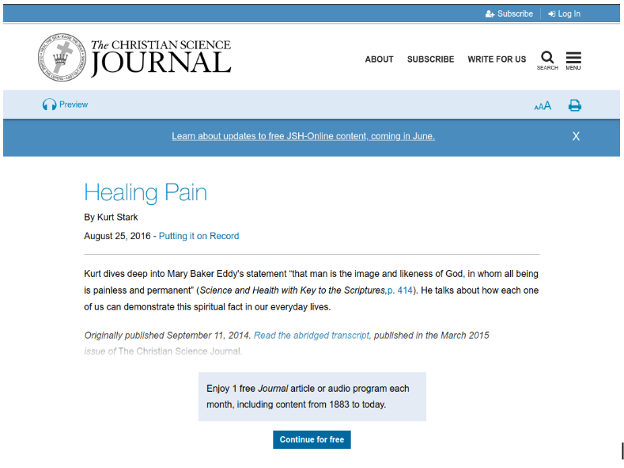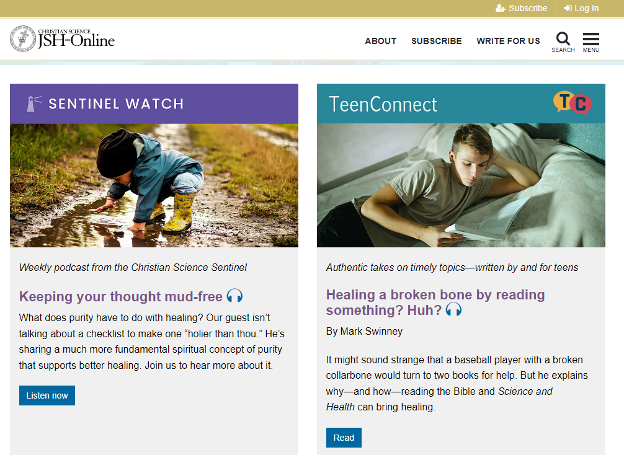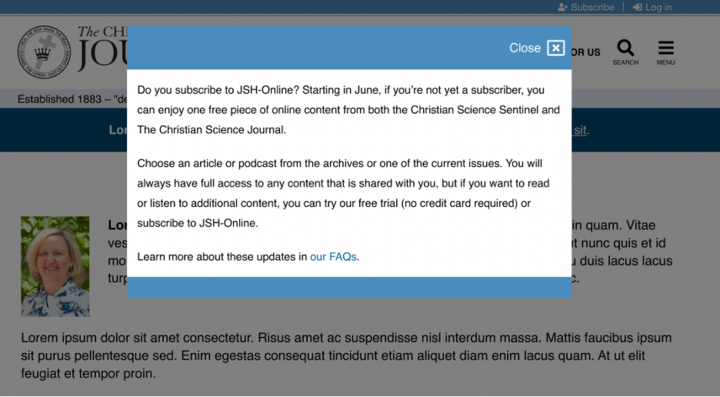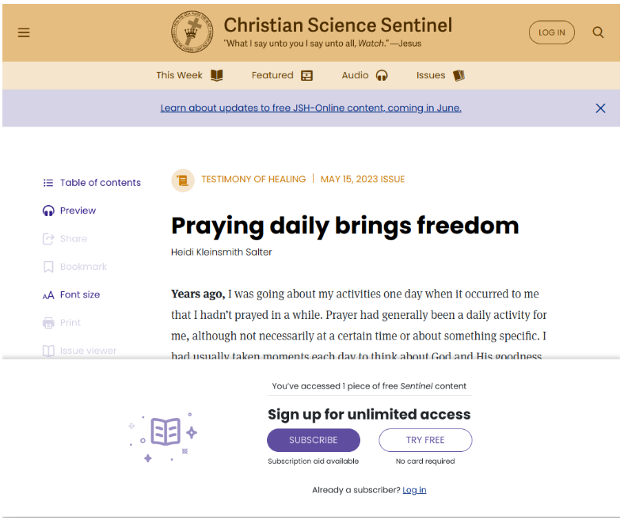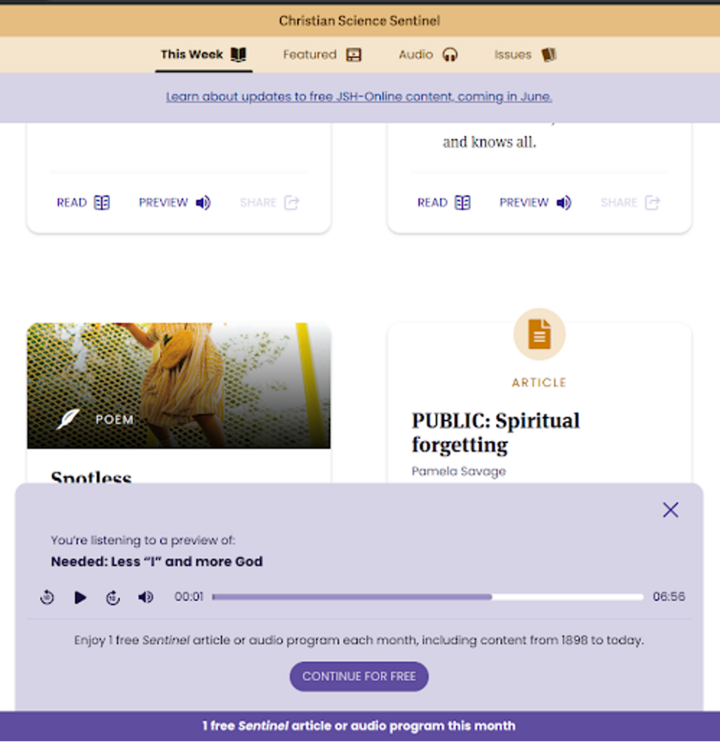Flexibility and scale are key features in new content paywall system
By: Thiago Campos Viana | July 24, 2023 | development and Business solutions
Subscription paywalls are an essential part of any publisher’s strategy to build a strong brand and diversified revenue stream. Our team at Mugo Web has worked with several publishers to implement paywalls based on content type, age, and subscription level. Imagine any criteria you can, and we’ve built a paywall to give site visitors gated access to premium content.
Throughout these efforts, flexibility has been a key requirement in building and managing how access to content is granted. Publishers introduce new content channels and media types, and users’ demand for information changes. Being able to track and capitalize on these trends is essential to maintaining reader interest and predictable revenue.
We recently worked with our longtime customer The First Church of Christ, Scientist (TFCCS), to modify the paywall of its multi-publication website, JSH-Online. The new paywall allows guest users to access a set number of subscriber-only content items across content channels. It also introduces new promotional behaviors for audio files, a key driver for subscriptions.
The project required us to learn a few new tactics with AJAX page loading and integration with a third-party rich media player. But most importantly, we worked closely with TFCCS to understand its goals and build tools that can scale to meet the publisher’s evolving needs.
Multiple channels and subscription drivers under one paywall
JSH-Online is the online home of three Christian Science Publishing Society (CSPS) publications.
- The Christian Science Journal: A monthly magazine that features long-form opinion and advice articles.
- Christian Science Sentinel: A weekly publication that focuses on TFCCS practice.
- The Christian Science Herald: Monthly multi-language translations of TFCCS content for international distribution, including a print component.
JSH-Online also hosts some premium book-length content and an extensive library of podcasts and other audio content, branded under the main publications. Audio is a key subscription driver for JSH-Online and is heavily promoted throughout the site UX.
The site does not have advertising, so subscriptions are essential for revenue and building long-term engagement with the audience for CSPS's faith-based publishing mission.
The subscription process itself is multi-faceted, with options including:
- A site-wide online-only monthly subscription, available initially as a 30-day free trial
- Print + online subscriptions to specific publications
- A site license for Reading Room study centers
- Student discounts and gift subscriptions
Mugo Web developed and maintains the subscription flow, which includes an integration with a print fulfillment shop and CSPS’s master CRM system, Salesforce.
The entire site is built in the Ibexa DXP content management system. It runs on a single install of Ibexa, but content for the three different publications and the umbrella JSH-Online site is held in separate, but very similar, databases.
A multi-factor, metered paywall solution
Our initial paywall implementation for JSH-Online was fairly straightforward. Permission to read a piece of content was based on time since publication -- typically 30 days -- but the team at CSPS would occasionally test various time windows. When guest users tried to access older content, they were presented with a clickable prompt to launch the subscription process.
The new paywall system we rolled out this year determines content access on a matrix of three factors:
- The publication where the content is housed (e.g., its home database)
- Content type (rich media or text-only)
- Count of items a guest user has accessed in the last time window.
The primary goals for these new behaviors are to allow guests to access content that is of deep personal interest to them, regardless of publication date. The new paywall will expose the value of JSH-Online’s extensive catalog of evergreen content. The site currently has about 300,000 articles and 4,000 podcasts, most of which remain relevant to the site’s faith-based mission for years.
Incremental rollout of a new paywall solution
The first step in the project was to publish a banner on the site’s homepage, visible only to non-logged-in guests, to announce the changes and, of course, encourage subscriptions. We also implemented a pop-up modal to let guests know about the coming changes.
As we rolled out the new paywall, we allowed guest users to access one piece of content:
- Of any content type
- Per individual publication
- Regardless of initial publication date
- For a 30-day time window
Of course, these settings are entirely editable. (More on that a bit later.)
As guest users try to access their first free content item, a popup (or modal) appears to let them know how many free articles they can access before needing to subscribe. They also are asked to confirm that they want to “unlock” the current piece of content to reveal the full piece of content.
If the user chooses to unlock the content item, the count of available free items is decreased by one. After the guest user reaches the limit for free items, attempts to access any specific piece of content are met by a modal announcing that they must first subscribe.
Clicking through lands them on the main subscription page, with the various options for digital-only or print + digital delivery.
Once the “unlock” time window resets, the content item will again be set as protected by the paywall. Each unlocked content item has its own running 30-day clock.
A mix of proven tools and new tactics
The technology decisions we’ve made in implementing the new paywall system are a mix of tools we’ve built and implemented in the past, plus a few new tactics we’ve had to research for this specific project. As always, we’ve tried to scale our dev efforts to match the business goals of the project.
Tracking content access with cookies
We are using first-party cookies to track how many and which content items a guest user has unlocked during the current time period.
Certainly, there are more sophisticated approaches to this functionality. But the team at CSPS understands the nominal risk of a guest user repeatedly deleting the cookie to gain additional content access. Ultimately, they want people to consume this information – losing a little revenue is worth it to them to advance their publishing mission. And client browser cookies are just a clean, simple way to execute this feature.
Here at Mugo Web, we pride ourselves on collaborating with our customers to find the best cost/benefit solution to a business need, and we try to avoid over-engineering our sites to requirements that simply are not necessary. This is a good example of that philosophy in action.
Seamless page load on unlock with AJAX
Under the old paywall system, when guest users tried to access gated content, the paywall message was presented as a call-to-action (CTA) embedded in the page build. Clicking through took the user directly to the subscribe page at a new URL.
Under the new paywall, a partial version of the item page loads under the subscription element that invites the guest to unlock content. If the guest decides to unlock the item, we want to present the full content without having to entirely rebuild the page.
So, we implemented a fairly simple JavaScript function that triggers a client-side event when the user clicks the unlock button. We use AJAX to get the desired data and add the complete content section to the page.
The net effect is a seamless user experience that requires little bandwidth to process. If a guest has added the content item to their unlock list (held in their cookie), the full page simply loads via AJAX.
Tracking unlock behaviors for content planning
We’ve integrated the paywall with Adobe Analytics via its API to collect data about guest users and the content they choose to unlock. Adobe Analytics offers a wide range of reporting features, particularly for event-driven user flows, as well as some anonymized audience profile data.
We simply use JavaScript to update some variables for the unlock event, then send that information to Adobe.
Understanding which content items are most attractive to guests will help CSPS determine which content channels and types to invest in moving forward. And understanding user behavior both before and after an unlock will help the CSPS team evaluate tweaks to the paywall access levels. For example, if guests who unlock one content item tend to return the following month and unlock another, increasing the monthly unlock count may encourage deeper engagement and higher subscriber conversion rates.
Managing paywall content elements and criteria in Ibexa
We’ve created editing tools within the Ibexa DXP that the CSPS team can use to:
- Toggle the presence of the announcement banner on and off
- Set the content of the announcement banner
- Set the content of the modals that present when guests try to access subscriber-only content items
All these tools fit seamlessly within the current site management.
The content access criteria (unlocked item limit, time window, etc.), is held in an Ibexa settings file that currently can be edited only by our dev team here at Mugo Web. However, as the CSPS team becomes more comfortable with editing these settings, we may build tools in Ibexa for that purpose as well.
Other changes to audio playback and promotion
A key feature in the new paywall is the ability to play a few minutes of a subscriber-only podcast or audio file as a preview of the content, similar to the way we present the first few paragraphs of text content along with the “unlock” modal.
We play about two minutes of the audio and then cross-fade to an audio message promoting subscription. The media player is presented alongside a message to the user about the current count of free content items available to them. Or, it encourages them to subscribe if they have used their free listen for the time period.
The JSH-Online site uses JW Player for all rich media. We are using events available via the player’s API to track the length of time the visitor has played the featured file, and then switch to another audio track at the correct moment.
Building your audience with smart paywall access
Paywalls are an essential part of building a strong multi-channel publishing strategy, and our team here at Mugo Web has accumulated a lot of experience with various approaches and tactics. Another example is our ongoing work with Habitat Magazine.
Our work on the JSH-Online paywall is expanding our tool kit for creating flexible, scalable paywalls that can adapt as your publishing strategy evolves.

